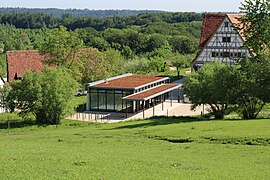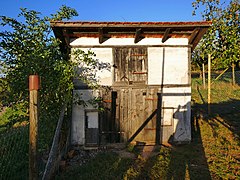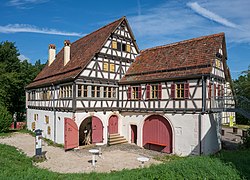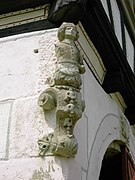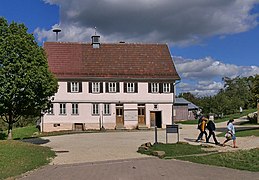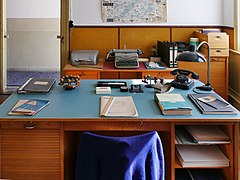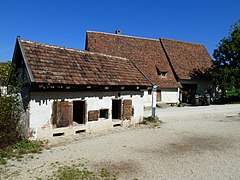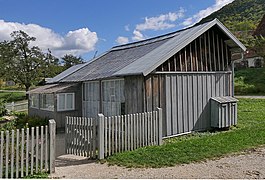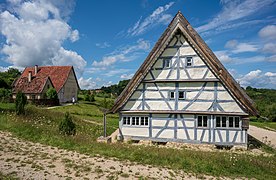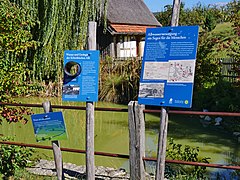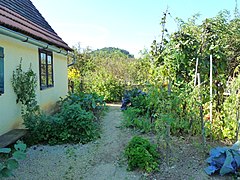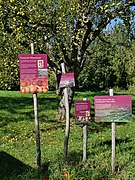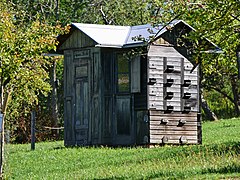Beuren open-air museum
 Museum village "Neckar Valley" |
|
| Data | |
|---|---|
| place |
Beuren (near Nürtingen) |
| Art |
Open air museum
|
| opening | 1995 |
| operator | |
| management | |
| Website | |
| ISIL | DE-MUS-219318 |
The Beuren open-air museum is one of seven regional open-air museums in Baden-Württemberg .
It was opened in 1995 and presents old buildings moved here from the Middle Neckar and Swabian Alb area . The museum is located northeast of Beuren near Nürtingen in the garb of Herbstwiesen and shows 24 historical buildings (as of 2018). The district of Esslingen is responsible for the Beuren open-air museum .
history
Since 1980, the Esslingen district has repeatedly considered whether an open-air museum could be created in the district. Negotiations were held with the districts of Böblingen, Ludwigsburg, Rems-Murr, Göppingen, Reutlingen, Tübingen and the city of Stuttgart in the catchment area of the planned regional open-air museum; despite intensive efforts, financial participation was not possible. In view of the onset of the recession at the time, the tight financial situation and other important tasks, the culture and school committee of the district council decided in 1982 to reject the establishment of the museum. They even began to get rid of stored buildings. The former village church of Tischardt , the "Tischardter Kirchle", was given away to the Neuhausen ob Eck open-air museum .
In 1985 the topic was taken up again in the district council. A proposal had been received from Beuren to set up the museum in the garb of autumn meadows . On December 19, 1995, the district council decided to build the museum at the Beuren location. Around 9 hectares of land were acquired and the Beuren municipality made around 4 hectares available free of charge. The groundbreaking ceremony took place in 1987 in the presence of the then Minister of Science and Art, Helmut Engler , and construction of the stored buildings began. On May 13, 1995, the last of the seven regional open-air museums in Baden-Württemberg with eight rebuilt buildings was opened.
building
Entrance area
The museum entrance leads through a modern, ecologically built entrance building with cash registers and the Tante-Helene shop operated by the museum's friends' association. Directly behind on the right is the house from Öschelbronn, which reopened in the museum in 2014 . This is only partially furnished historically. The larger part of the house is now used as a modern conference building with barrier-free conference rooms. Directly behind it is a house with a joinery from Ohmenhausen . In front of this building are a fruit mill from Owen and a chicken coop from Stuttgart-Birkach .
Neckarland village
On a tour, you can see a residential and farm building from Tamm , which also houses the museum restaurant. Right next to it, built across the brook, is the baking and washing house from Sielmingen . A barn Gärtringen is as an exhibition abrasive used. A bakery from Sulzgries and the school and town hall from Häslach follow. You can also visit a barn from Beuren (Schlegelscheuer), a pigsty from Ehningen and a living-stable house from Beuren.
A special feature is the former Hofmann photo studio from Kirchheim unter Teck , located behind the town hall , in which Hermann Hesse was already photographed. It is one of the few free-standing daylight photo studios preserved in Europe. A comparable one is in the Ryedale Folk Museum .
Alb village
On the way to the Alb village you can see a lime kiln , a cattle shed and the sheepfold from Schlaitdorf . In this second group of houses you can see a day laborer's house from Weidenstetten , a farmhouse from Aichelau with the associated Ausgedinghaus and a weaver's house from Laichingen .
Gardens, fields, museum animals
A special feature of the museum is that it was built within orchards that are older than the museum. For most trees, the variety has now been determined by pomologists . Also worth seeing are the museum fields and the house gardens with old cultivated plants such as Alb lentils , old grains, hemp , Jerusalem artichoke , potatoes and Filderspitzkraut. The museum keeps regional breeds of Merino sheep , goats , geese, chickens and rabbits, some of which are threatened with extinction , and has a snail garden with Roman snails . In addition to the museum, some meadows are used as pasture by neighboring farmers and Scottish highland cattle can sometimes be seen. For beekeeping bees trolley is Ohmden and the apiary from Köngen ready.
Gateway to the biosphere area and the GeoPark Swabian Alb
Large parts of the Swabian Alb biosphere area are in the catchment area of the Beuren Museum. For this reason, it is predestined to deepen topics relating to the biosphere area. The open-air museum is therefore also one of 15 decentralized information centers in the biosphere area. In addition, since January 2017 the open-air museum has been one of 26 information points of the UNESCO Geopark Swabian Alb .
Support association
The Friends of the Freilichtmuseum Beuren eV, founded in 1994, supports the further expansion of the open-air museum with its activities. There are now around 500 members of the Beuren Open Air Museum Friends Association.
The focal points in the work of the development association include, among other things
- the operation of the "Tante-Helene-Lädles" in the open-air museum (since 1997);
- the annual day of action, including demonstrations of old handicrafts and hands-on activities (since 1996, always on the 3rd Sunday in June);
- the construction of a “pedagogical barn” (1997/1998), in which children and young people can experience the Beuren open-air museum “with all their senses” through a variety of offers;
- the financial contribution to the reconstruction of the Hofmann photo studio (2000–2002);
- financial participation in the dismantling and reconstruction of a late medieval farmhouse in the Swabian Alb (2006 ff).
- the financial contribution to the reconstruction of the garden hall from Geislingen an der Steige, in which the Erlebnis.Genuss.Zentrum for old varieties of the open-air museum is to be set up.
Events
Every year there are traditionally several days of action:
- Shepherd days
- Museum festival of the Friends of the Beuren Open Air Museum
- Bulldog and tug meetings
- Big "Moschtfescht", an event about orchards and the production of apple cider
See also
literature
- Steffi Cornelius / Barbara Wehling: House stories - A guide through the Beuren open-air museum , publisher: Landkreis Esslingen 1995, ISBN 978-3980445108
Web links
- Beuren Open Air Museum Official website
- Homepage of the Friends' Association

